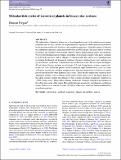Files in this item
Milankovitch cycles of terrestrial planets in binary star systems
Item metadata
| dc.contributor.author | Forgan, Duncan | |
| dc.date.accessioned | 2017-03-28T15:30:12Z | |
| dc.date.available | 2017-03-28T15:30:12Z | |
| dc.date.issued | 2016-08-20 | |
| dc.identifier | 249488826 | |
| dc.identifier | ebf9be4d-5278-44d1-9401-bb7db227075f | |
| dc.identifier | 85015058757 | |
| dc.identifier | 000393566000039 | |
| dc.identifier.citation | Forgan , D 2016 , ' Milankovitch cycles of terrestrial planets in binary star systems ' , Monthly Notices of the Royal Astronomical Society , vol. 463 , no. 3 , pp. 2768-2780 . https://doi.org/10.1093/mnras/stw2098 | en |
| dc.identifier.issn | 0035-8711 | |
| dc.identifier.uri | https://hdl.handle.net/10023/10546 | |
| dc.description | DHF gratefully acknowledges support from the ECOGAL project, grant agreement 291227, funded by the European Research Council under ERC-2011-ADG. | en |
| dc.description.abstract | The habitability of planets in binary star systems depends not only on the radiation environment created by the two stars, but also on the perturbations to planetary orbits and rotation produced by the gravitational field of the binary and neighbouring planets. Habitable planets in binaries may therefore experience significant perturbations in orbit and spin. The direct effects of orbital resonances and secular evolution on the climate of binary planets remain largely unconsidered. We present latitudinal energy balance modelling of exoplanet climates with direct coupling to an N-Body integrator and an obliquity evolution model. This allows us to simultaneously investigate the thermal and dynamical evolution of planets orbiting binary stars, and discover gravito-climatic oscillations on dynamical and secular time-scales. We investigate the Kepler-47 and Alpha Centauri systems as archetypes of P- and S-type binary systems, respectively. In the first case, Earth-like planets would experience rapid Milankovitch cycles (of order 1000 yr) in eccentricity, obliquity and precession, inducing temperature oscillations of similar periods (modulated by other planets in the system). These secular temperature variations have amplitudes similar to those induced on the much shorter time-scale of the binary period. In the Alpha Centauri system, the influence of the secondary produces eccentricity variations on 15 000 yr time-scales. This produces climate oscillations of similar strength to the variation on the orbital time-scale of the binary. Phase drifts between eccentricity and obliquity oscillations creates further cycles that are of order 100 000 yr in duration, which are further modulated by neighbouring planets. | |
| dc.format.extent | 13 | |
| dc.format.extent | 5367834 | |
| dc.language.iso | eng | |
| dc.relation.ispartof | Monthly Notices of the Royal Astronomical Society | en |
| dc.subject | Astrobiology | en |
| dc.subject | Methods: numerical | en |
| dc.subject | Planets and satellites: general | en |
| dc.subject | Astronomy and Astrophysics | en |
| dc.subject | Space and Planetary Science | en |
| dc.subject | DAS | en |
| dc.title | Milankovitch cycles of terrestrial planets in binary star systems | en |
| dc.type | Journal article | en |
| dc.contributor.sponsor | European Research Council | en |
| dc.contributor.institution | University of St Andrews. School of Physics and Astronomy | en |
| dc.identifier.doi | 10.1093/mnras/stw2098 | |
| dc.description.status | Peer reviewed | en |
| dc.identifier.url | https://arxiv.org/abs/1608.05592 | en |
| dc.identifier.grantnumber | en |
This item appears in the following Collection(s)
Items in the St Andrews Research Repository are protected by copyright, with all rights reserved, unless otherwise indicated.

